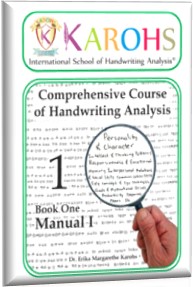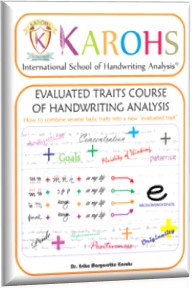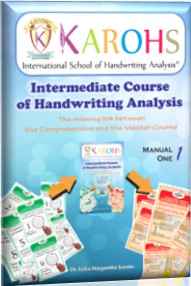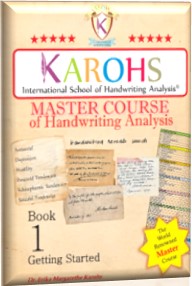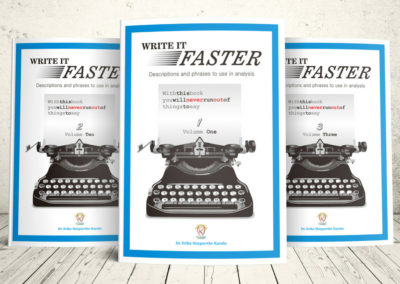
Free Article about Handwriting Analysis
From “Sunday Lessons III”
- Sunday Lesson #16: Emphasis
Initial emphasis
Initial emphasis means exaggeration of the first stroke, letter or word either in size, height, pressure, or form.
Indicators of initial emphasis:
- Careful execution of all details of the letter.
- Embellishment of initial letters, words, or strokes.
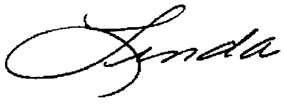
- Exaggeratedly high first strokes in capital letters.
An exaggeratedly high first stroke in capitals is one of the indicators of an authoritarian personality.
- Exaggeratedly high capital letters.

Since handwriting is being experienced as “standing,” the tendency to enlarge initial letters “expresses the writer’s preference for dominating forms. This, in turn, says Klages, “is rooted in his self-feelings.
Exaggeratedly high initial letters manifest a desire for superiority, a need for greatness.
Preyer explains that disproportionate initial height exposes immoderate requests on the part of the writer. Whether in a conversation or a speech he will make excessive demands on others’ time and will always put his own concerns first.
Klages theorizes that capitals increasing in height show ambition. This, of course, is in keeping with the interpretation of “looking up,” since to the ambitious person the desired goal seems “higher upon “lofty,” or “elevated.”

Extreme narrowness in very tall capitals reveals exaggerated sensitiveness because of unsatisfied needs for recognition.
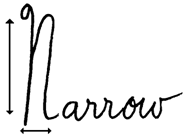
Mendel speaks of “social timidity, professional jealousy, ambition without adequate imagination, sobriety, coolness” and “rigor.” (Personality in Handwriting, New York 1975, p. 160)
- Exaggeratedly wide capitals
To compensate for strong insecurities, these writers may put up a front of arrogance. In relationships, the can be rude and impertinent. Extremely vulnerable to criticism, they may try keep themselves from losing face by resorting to subterfuge or misrepresentation.
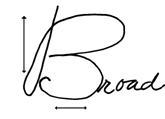
If initials are very high with an extremely broad base, the writer elevates himself and may mislead others about his competence. Once he has successfully duped those around him, he starts to believe these fabrications himself.’
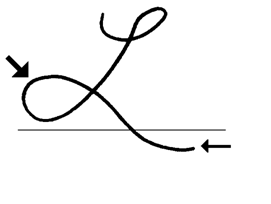
- Heavier pressure on initial letters
- Letter forms deviating from the rest of the word.
- Underlining.
- Use of a letter from a different writing system.
- Otherwise calling attention to a word or phrase.
The meaning of initial emphasis
Initial letters are optically in a conspicuous place and symbolically by their size and form depict a person’s self-feelings. This holds especially true for the personal pronoun I, for initials and signatures.
Saudek explains that initial emphasis “presupposes concentration on the act of writing, which is strongest just at the beginning, decreases the tendency to the right, and is one of the signs of an unnatural act of writing”. (Experiments with Handwriting, London 1928, p. 134)
Brooks explains that “this amounts to deliberate ornamentation, which is inconsistent with full spontaneity and naturalness and means that the writer is trying to impress the reader with the importance of what he is going to say.”
Brooks clarifies that “In slow writing, this shows a pedantic, pompous turn of mind.” In low form level writing, it also reveals “garrulity, boastfulness, and uncritical self-admiration”.
In quick writing, says Brooks, it demonstrates “a state of excitement or exaltation, at least while the script was being penned.” With high form level, it indicates “zeal, enthusiasm and a love of self-expression”. (Your Character from Your Handwriting, London, 1950).
Kind regards and much success to all of you!
Dr. Erika Margarete Karohs
“Practicing graphologist”
I hope you enjoy “Sunday Lessons Series III”. If you have any questions or would like to recommend topics, please feel free to email me at info@karohs.com
Flash Back to the Complete Chapter:
back to Free ARTICLE 1. Rolled Strokes 2. Air Strokes & Alignments 3. Thinking Patterns (1) 4. Thinking Patterns Continued (2) 5. Thinking Patterns Continued (3) 6. Accident Proneness 7. Answers to Quiz from Lesson from No.6 8. More Answers from Lesson from No. 6 9. More Air stroke Discussion 10. Directional Pressure 11. Double Curves 12. Non-Manager Discussions 13. The Letter “M” 14. Soldered (sautered) writing 15. 2 Most Frequent Questions 16. Emphasis
Quick Link:
Back to ARTICLE FAQ (Frequently Asked Question) Price Information Registration Process : How to Enroll TESTIMONY : What Student Says about the Courses Back to COURSES Information
See detail courses programs (click the image below):
Copyright © 2018 the KAROHS International School of Handwriting Analysis®. All rights reserved.
No image or portion of this website may be copied or reproduced without written permission.
Write It Faster
If you:
- have trouble writing analyses
- write a lot of analyses
- are just starting out writing analyses
This book is PURE GOLD. With nearly 800 pages, Write It Faster is the most comprehensive book of trait descriptions available today. You can simply copy and paste the phrases into your analysis. Trait descriptions in “Write It Faster” are so plentiful that you will not run out of things to say, no matter how many analyses you write.
Info: 1 Volume; 705 Pages Price: $ 75


